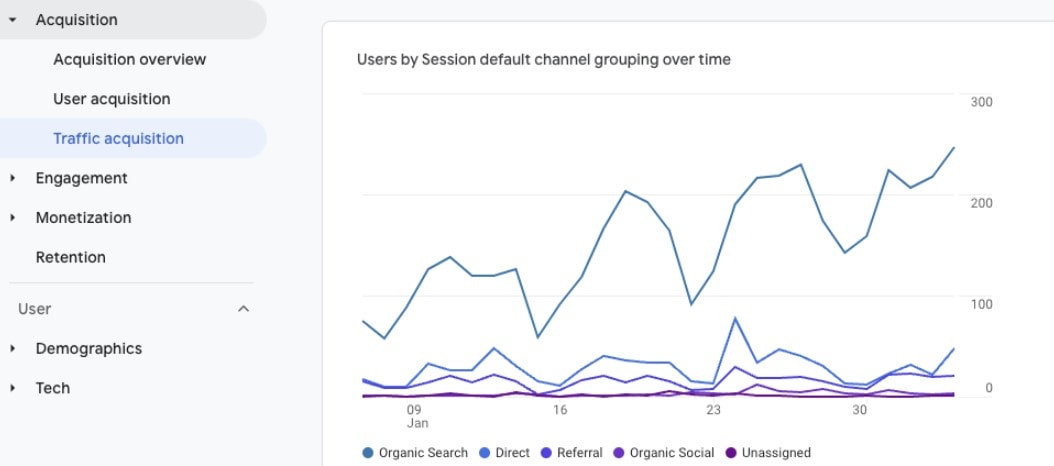Dive deep into the intricate maze of business strategies with our meticulously curated list titled, “10 Smart Goals Examples for Business”. Elevate your enterprise by anchoring it with SMART (Specific, Measurable, Relevant, Achievable, Time-bound) objectives. The journey to thriving in the competitive market often requires a robust foundation of clear-cut aims. This guide provides just that! Here’s a sneak peek into what the compilation entails:
- Tailored insights that streamline decision-making ✅
- Benchmarks that resonate with global standards 📈
- Strategies that drive sustainable growth 📊

Harness the power of the SMART methodology and give your business the traction it deserves. And for those passionate about optimizing their strategies further, consider leveraging the Plerdy tool, a stalwart in CRO & UX enhancements. Elevate, innovate, and dominate with a strategic approach that speaks volumes about your brand’s ambition. Grab this article, refine your approach, and set the stage for unmatched business triumph.
What are SMART goals?
SMART goals have revolutionized the way businesses set objectives and measure success. To grasp their potency, it’s essential to delve into each letter of the acronym:
- Specific: Drill down to the nitty-gritty. A tech startup might aim to “Enhance user interface experience” instead of the nebulous “Improve product.”
- Measurable: Quantify achievements. An online store can target “Boost online sales by 15% in Q2” as opposed to the vague “Sell more.”
- Achievable: Set realistic targets. A cafe wouldn’t just aim to “Serve more customers,” but “Introduce two express lines during peak hours to serve 20% more patrons daily.”
- Relevant: Ensure goals align with your business strategy. A fashion brand, focusing on sustainable wear might opt to “Source 70% of materials from eco-friendly suppliers” over a broad “Change suppliers.”
- Time-Bound: Set clear deadlines. A gym might strive to “Increase memberships by 200 in the upcoming summer months,” rather than an open-ended “Get more members.”
By employing SMART goals, businesses—from artisan bakeries to vast tech conglomerates—can navigate challenges, pinpoint opportunities, and transform ambitions into tangible achievements. Crafting precise, actionable objectives acts as the bedrock for sustainable growth, pushing companies to not just dream big but also act smart.
Importance of Setting SMART Goals in Business

In the bustling landscape of commerce, setting SMART goals has emerged as a cornerstone strategy for businesses keen on achieving measurable growth. Precision and clarity underpin these objectives, making them instrumental in driving forward momentum.
For instance, a local craft brewery, instead of vaguely wanting to “boost sales,” might lay out a goal to “Expand distribution to 10 regional stores and increase sales volume by 15% in the upcoming quarter.” This SMART goal lays out a clear roadmap:
- Specific: Targeting regional store distribution.
- Measurable: Quantifying the sales volume increase.
- Achievable: Grounding the ambition in realistic growth figures.
- Relevant: Aligning with the brewery’s expansion focus.
- Time-Bound: Setting a quarter as the timeframe.
In another scenario, a digital marketing firm won’t just aspire to “attract more clients” but will zero in on “Securing five contracts from e-commerce businesses within the next two months.” By honing in on SMART objectives, companies get more than a distant vision; they acquire a detailed, actionable plan.
This precise approach to goal setting ensures businesses, from bustling tech hubs to cozy neighborhood bookstores, remain on track, minimize sidetracks, and consistently chart growth. It’s a strategy that not only elevates ambition but also empowers achievement, anchoring businesses in a trajectory of success.
List of Best 10 Smart Goals Examples
Diving into the “10 Smart Goals Examples for Business” feels like striking gold; the compilation is not just insightful, but it’s tailored to give businesses that much-needed roadmap. Every entrepreneur worth their salt knows that setting clear and tangible goals is the linchpin of success, and this list hits the nail on the head. If you’re looking to separate the wheat from the chaff in your business strategies, these SMART goals serve as the ideal benchmark.
Smart Goals Example #1: Financial Goals

Setting financial goals using the SMART framework acts as a catalyst in the corporate journey, propelling businesses from vague aspirations to tangible outcomes. Financial objectives, especially in the business realm, need precision, direction, and a touch of ambition.
Consider a niche artisanal cheese store. While they might desire to “amplify profits,” a SMART goal would push them to “Boost monthly sales by 15% through launching two exclusive cheese varieties and targeting weekend markets by the end of Q3.”
Key tenets to keep in mind while setting these financial goals:
- Specific: Narrow down to granular details. Rather than “increase exports,” a footwear manufacturer might target “Expand European market share by introducing three eco-friendly shoe models.”
- Measurable: Embed metrics. An online tutoring platform won’t just “enroll more students” but will “Grow student base by 200 with a focus on science courses in Q2.”
- Achievable: Ground aspirations in reality. A local diner, aiming for growth, might “Introduce a loyalty program projected to upsell orders by 8%.”
- Relevant: Ensure alignment with overarching company visions. A tech firm, instead of blindly chasing profits, might “Diversify income streams by tapping into AI-driven solutions, forecasting a revenue increase of 25%.”
- Time-Bound: Frame goals within a timeframe. An event management company might “Seal five corporate event deals by year-end.”
By intertwining SMART principles with financial objectives, diverse businesses—from luxe spas to gritty automotive repair shops—can create a blueprint for success. This methodical approach not only sets the stage for growth but also defines the pathway to get there, turning financial dreams into achieved milestones.
Smart Goals Example #2: Customer-Related Goals
Customer-related goals, when sculpted using the SMART framework, transform businesses from being merely transactional to truly transformative. Establishing these objectives with precision, accountability, and foresight ensures that companies aren’t just chasing numbers but building lasting customer relationships.
For instance, a boutique skincare brand might go beyond wanting to “increase brand loyalty.” Instead, they’d set a SMART goal like “Boost repeat purchases by 20% in Q2 through the introduction of a sustainable packaging initiative.”
Essential elements to consider when framing these customer-centric objectives:
- Specific: Dive deep into the details. A travel agency, rather than simply wanting to “improve customer feedback,” might focus on “Achieving a 90% satisfaction rate on tropical vacation packages through enhanced local experiences.”
- Measurable: Attach quantifiable metrics. An e-commerce platform won’t just “reduce complaints” but “Decrease return requests by 15% by enhancing product descriptions and imagery.”
- Achievable: Ground ambitions in practicality. An upscale bistro aiming to enhance customer experience might “Roll out an exclusive chef’s tasting menu anticipated to drive a 10% increase in weekday reservations.”
- Relevant: Ensure goals resonate with the business vision. A fitness studio, instead of indiscriminately adding classes, might “Expand morning yoga sessions, predicting a 30% surge in early bird memberships.”
- Time-Bound: Affix a clear deadline. A digital consultancy might “Garner 50 client testimonials spotlighting website design expertise by the end of Q4.”
Employing SMART principles with customer-related objectives allows businesses, from tech startups to artisan bakeries, to foster genuine connections, champion client needs, and in the process, carve out a niche of excellence. This strategy, underpinned by intention and insight, becomes the linchpin of sustainable business growth.
Smart Goals Example #3: Product and Service Goals

In the bustling corridors of commerce, product and service goals stand out as vital pillars. When crafted with the SMART framework, they anchor businesses to actionable strategies and measurable results, ensuring that companies navigate the market currents with finesse and agility.
Imagine a coffee shop keen on revamping its offerings. Instead of a generic “expand the menu,” they’d pivot with a SMART goal like “Introduce five plant-based latte options by Q3 to cater to the growing vegan clientele.”
Here’s a snapshot of how diverse industries can sculpt product and service goals with precision:
- Specific: Drill down to the core. A tech enterprise wouldn’t just “update software” but aim to “Release a version addressing the top three user-reported bugs within two months.”
- Measurable: Ensure there’s a yardstick. A fashion brand isn’t merely “going green” but “Transitioning to 100% sustainable fabrics for the summer collection.”
- Achievable: Balance ambition with feasibility. A publishing house might “Collaborate with two renowned authors for exclusive book launches in the next fiscal year.”
- Relevant: Goals should dovetail with the broader vision. An auto repair shop, rather than chasing every trend, might “Specialize in electric vehicle servicing, anticipating local market shifts.”
- Time-Bound: Encase aspirations in a timeframe. An artisanal bakery may “Unveil a gluten-free line by the festive season, responding to customer feedback.”
Harnessing SMART principles for product and service goals lets businesses—from gourmet diners to innovative startups—chart out paths of distinction. This approach, steeped in clarity and commitment, positions brands to deliver unmatched value and capture market sentiment effectively.
Smart Goals Example #4: Employee and Team Goals
In the vibrant tapestry of a thriving business, the threads of employee and team goals, meticulously crafted, determine the fabric’s strength and allure. By embedding SMART strategies within these goals, businesses set themselves up to knock down barriers and rally their troops with vigor and focus.
Picture a sales team from a tech startup. Instead of settling on “boost sales,” they gear up with a smart goal: “Increase SaaS subscriptions by 15% in Q2 by targeting emerging enterprises.”
Here’s how diverse sectors can benefit from tailored employee and team goals:
- Specific: Dive deep. An advertising agency might aim not just to “improve client relations,” but to “Implement weekly status calls with top-tier clients for project transparency.”
- Measurable: It’s vital to track progress. A law firm isn’t just “reducing overtime” but is “Cutting down employee overtime by 20% through efficient task delegation.”
- Achievable: Match goals with realistic benchmarks. A tech support team could “Decrease average call resolution time to under five minutes by implementing a comprehensive training module.”
- Relevant: Align goals with overarching objectives. An e-commerce platform might “Streamline the customer support process, ensuring 90% of inquiries get resolved within 24 hours.”
- Time-Bound: Seal objectives within a clear timeframe. A marketing team can “Launch three targeted campaigns for the winter product line by November.”
Crafting employee and team goals using the SMART framework elevates businesses, guiding them through challenges and empowering teams. Such goals, precise and actionable, set the stage for groundbreaking achievements and long-term success.
Smart Goals Example #5: Operational Goals

Operational goals serve as the robust backbone of any forward-thinking enterprise. Embracing the SMART approach in carving out these objectives ensures that businesses streamline processes, enhance efficiency, and drive growth. Each operational goal, sharp and meticulously crafted, creates a path to accomplish overarching visions with clarity and precision.
Let’s delve into a few exemplar operational objectives informed by the SMART method across diverse industries:
- Manufacturing: “Cut machinery downtime by 25% in Q3 through routine maintenance every 14 days.”
- Hospitality: “Boost guest check-ins during weekdays by offering tailored promotional packages, targeting a 20% uptick by end of Q2.”
- E-commerce: “Enhance product delivery speed by partnering with local logistics providers, aiming for 95% of orders to reach customers within 48 hours.”
By weaving SMART criteria into operational goals, businesses experience:
- Focused Vision: Instead of vaguely wanting to “improve operations,” a food distributor might home in on “Reducing food waste by 15% by year’s end through better inventory tracking.”
- Measurable Outcomes: Rather than hoping to “serve customers better,” a salon could aspire to “Increase appointment punctuality by ensuring 98% start on time through the next quarter.”
- Enhanced Accountability: Instead of just “upgrading tech infrastructure,” an IT firm could commit to “Implementing two-factor authentication for all client accounts by June.”
Operational goals, rooted in the SMART framework, bring about transformative change, ensuring businesses stay on point, optimize resources, and deliver exceptional value. With such clear directives in place, enterprises can navigate challenges, keep teams motivated, and scale with unmatched agility.
Smart Goals Example #6: Marketing and Sales Goals
In the vibrant landscape of marketing and sales, setting clear-cut goals becomes the linchpin for success. Harnessing the power of SMART objectives ensures that businesses can zero in on growth avenues, amplify brand resonance, and turbocharge sales figures. When you marry the meticulousness of the SMART framework with marketing and sales aspirations, you weave a blueprint for dynamic outcomes and powerful market presence.
Dive into these thoughtfully crafted marketing and sales objectives, grounded in the SMART methodology, from a gamut of industries:
- Publishing: “Boost eBook sales by 30% in Q4 through a dedicated social media ad campaign targeting bibliophiles aged 20-35.”
- Fitness: “Ramp up gym memberships by hosting three local community workshops, aiming for a 20% increase by Q2’s close.”
- Fashion Retail: “Drive online store traffic by 40% in the next six months by rolling out a bi-weekly blog series spotlighting seasonal fashion trends.”
The brilliance of SMART-infused marketing and sales goals unfurls in:
- Tailored Strategies: Rather than casting a wide net with “enhancing brand awareness”, a cosmetics brand could strategize to “Cement brand recall by launching a user-generated content campaign, rallying 1,000+ customer reviews in 60 days.”
- Tangible Milestones: Instead of a nebulous “increase sales”, a tech startup could target “Skyrocket SaaS subscriptions by offering a 14-day free trial, gunning for 2,000 sign-ups in Q1.”
- Unwavering Accountability: Bypassing the general “expand market reach”, a beverage company might fixate on “Breaking into three metropolitan areas with pop-up stalls by year-end.”
By intertwining marketing and sales aspirations with SMART guidelines, businesses can chart out laser-focused strategies, galvanize teams, and harvest lucrative returns. With such well-defined targets, companies stand poised to capture market pulse, rev up engagement, and cultivate unwavering customer loyalty.
Smart Goals Example #7: Research and Development Goal
![]()
In the bustling ecosystem of modern business, the lifeline of sustainable growth often rests in the realm of Research and Development (R&D). Orchestrating the dance of innovation, R&D thrives best when anchored by SMART goals. Setting sharp, data-driven objectives enables enterprises to push boundaries, ignite creativity, and lead the way in industry advancements.
Take a gander at these R&D objectives, sprouted from the SMART framework, across diverse sectors:
- Pharmaceuticals: “Complete clinical trials for our Type-2 diabetes drug, targeting FDA approval within 18 months.”
- Automotive: “Reduce battery recharge times for our electric vehicles by 25% over the next two years through focused engineering innovations.”
- Agriculture: “Develop and patent two drought-resistant crop strains by the close of Q3 next year, leveraging advanced genetic engineering techniques.”
The allure of SMART-based R&D objectives lies in:
- Directed Innovation: Instead of vaguely “improving software capabilities”, a tech firm might pinpoint “Enhance our CRM’s AI features to predict customer behaviors with 95% accuracy in the next 12 months.”
- Measurable Progress: Bypassing the general “create better products”, a beauty brand can zero in on “Unveil a skincare line that reduces skin redness by 50% based on user trials conducted over six months.”
- Dynamic Adaptability: Rather than just “exploring sustainable alternatives”, an apparel company could strive for “Integrating three eco-friendly fabrics into our summer collection, aiming for a 30% reduction in carbon footprint.”
As businesses harness the vigor of SMART-driven R&D goals, they pave avenues for groundbreaking discoveries, bolster brand reputation, and secure a competitive edge. Riding on crystal-clear aspirations, the promise of innovation not only beckons but also revolutionizes industries.
Smart Goals Example #8: Sustainability and Environmental Goals
In the modern business landscape, sustainability and environmental initiatives aren’t just buzzwords — they’re vital anchors driving impactful change. By weaving SMART goals into these initiatives, enterprises can foster tangible growth, demonstrate environmental stewardship, and propel their brand image to unparalleled prominence.
Let’s dive straight into sustainability objectives, rooted in the SMART ethos, across a spectrum of industries:
- Hospitality: “Slash single-use plastics in all resorts by 70% by the end of 2024 through partnerships with eco-friendly suppliers.”
- Construction: “Incorporate green building techniques in 80% of projects by 2025, focusing on energy-efficient materials and design.”
- Textiles: “Transition to organic cotton in 60% of our product line by Q2 2023, supporting eco-conscious agriculture.”
Advantages of weaving SMART principles into sustainability targets:
- Clear Roadmaps: Rather than vaguely aiming to “reduce emissions”, a transportation firm can declare: “Decrease fleet carbon emissions by 40% in three years by integrating hybrid vehicles.”
- Accountable Growth: Bypassing generic “green initiatives”, a food brand might opt for “Achieve zero food waste in our facilities by the close of 2024 through comprehensive waste management practices.”
- Stakeholder Engagement: Instead of simply “supporting green causes”, a corporation could lay out “Fund three community-based reforestation projects annually, targeting 50,000 trees planted by 2026.”
Harnessing the potency of well-defined, SMART-centered environmental goals, businesses not only carve a distinct space for themselves in the market but also champion the urgent call for global sustainability. Through meticulous strategy and dedication, they breathe life into a greener, more prosperous future.
Smart Goals Example #9: Strategic Partnership Goals

In the dynamic tapestry of the modern corporate landscape, strategic partnerships stand out as pillars that bolster growth and mutual success. Drawing up SMART goals in these collaborations elevates businesses, ensuring they forge ties that are both purposeful and results-oriented.
Diving into varied sectors, here’s a glimpse of strategic partnership objectives steeped in the SMART framework:
- Technology: “Boost software integration capabilities by partnering with three industry-leading cloud providers by 2024 to enhance end-user experience.”
- Retail: “Expand global reach by aligning with two international e-commerce platforms, aiming for a 25% uptick in overseas sales by Q3 2023.”
- Healthcare: “Collaborate with five local clinics by 2025 to provide comprehensive telehealth services, aiming to serve 10,000 patients monthly.”
Leveraging SMART goals in strategic partnership pursuits offers:
- Tailored Growth Paths: Sidestepping the vague desire to “expand networks”, a fintech firm might hone in on “Align with four banks by 2024 to enhance payment gateway offerings.”
- Enhanced Synergy: Moving beyond generic “collaborations”, a cosmetics brand could pinpoint “Seal deals with three influencers in the eco-beauty niche by year-end, amplifying organic reach by 20%.”
- Stakeholder Assurance: Instead of a broad “invest in partnerships”, an agribusiness can articulate “Join forces with two organic farms by 2024, ensuring 30% of our produce is pesticide-free.”
By interlacing strategic partnerships with sharp, SMART goal-setting, businesses lay down a track for collaborative triumph. This alignment not only fosters mutual advancement but also galvanizes each enterprise’s journey towards industry leadership. A pathway defined by precision and purpose paves the way for a flourishing shared future.
Smart Goals Example #10: Expansion and Growth Goals
In the bustling landscape of commerce, businesses constantly chase expansion and growth. But success doesn’t come from vague aspirations; it’s born out of concrete, well-articulated SMART goals.
Illustrating this with real-life scenarios:
- Hospitality: “Amplify our footprint by launching three boutique hotels in the Pacific Northwest by 2024, targeting a 15% revenue increase.”
- E-commerce: “Broaden our product range by integrating 50 local artisan brands by the end of 2023, aiming to elevate sales by 20%.”
- Publishing: “Dive into the audiobook market by converting 60% of our current titles by 2025, striving for a 30% surge in overall book sales.”
The magic of embedding SMART goals into expansion strategies:
- Pinpoint Accuracy: A gourmet coffee firm might aim for “Breaking into two additional metropolitan markets in the West Coast by 2024, expecting a 25% sales boost.” instead of “grow”.
- Measurable Outcomes: Bypassing a mere “increase sales”, an apparel brand might target “Expand production to cater to plus sizes by Q2 2023, forecasting a 15% revenue hike.”
- Timely Execution: Eschewing a general “expand services”, a logistics company can dial in on “Extend operations to include cold-chain logistics by 2024, projecting a 20% customer base increase.”
By marrying expansion pursuits with the precision of SMART goal-setting, businesses can streamline their ambitions. Such targeted objectives not only catalyze growth but also sharpen the trajectory, ensuring that every move aligns with a vision of success. Through clarity and commitment, firms can navigate the future, poised for both breadth and depth in their industry influence.
Conclusion about Smart Goals Examples for Business
Navigating the intricate tapestry of business development, we’ve brought to you a masterly crafted “10 Smart Goals Examples for Business”. Setting SMART (Specific, Measurable, Achievable, Relevant, Time-bound) objectives isn’t just another tick off the to-do list; it’s the very fabric of organizational success. ?
Over the weeks, business professionals have turned the pages, read through the templates, and noted the essential tips, all to harness the power of SMART. Here’s what you’ve journeyed through:
- Innovatively compiled goals that set the stage for expansion ?.
- Expert insights that help streamline persistent efforts for sustainable growth.
- Actionable steps to evaluate and amplify business performance metrics ?.
Now, before you sign off, a final pro tip: Enhance your online strategy with the Plerdy tool – a gem for SEO & UX analysis. It’s not just about ticking off tasks on your Smartsheet but truly making each action count. Dive into the hub of resources and make every strategy, every email, and every meeting a stepping stone to success. Let’s build smarter together. ?
